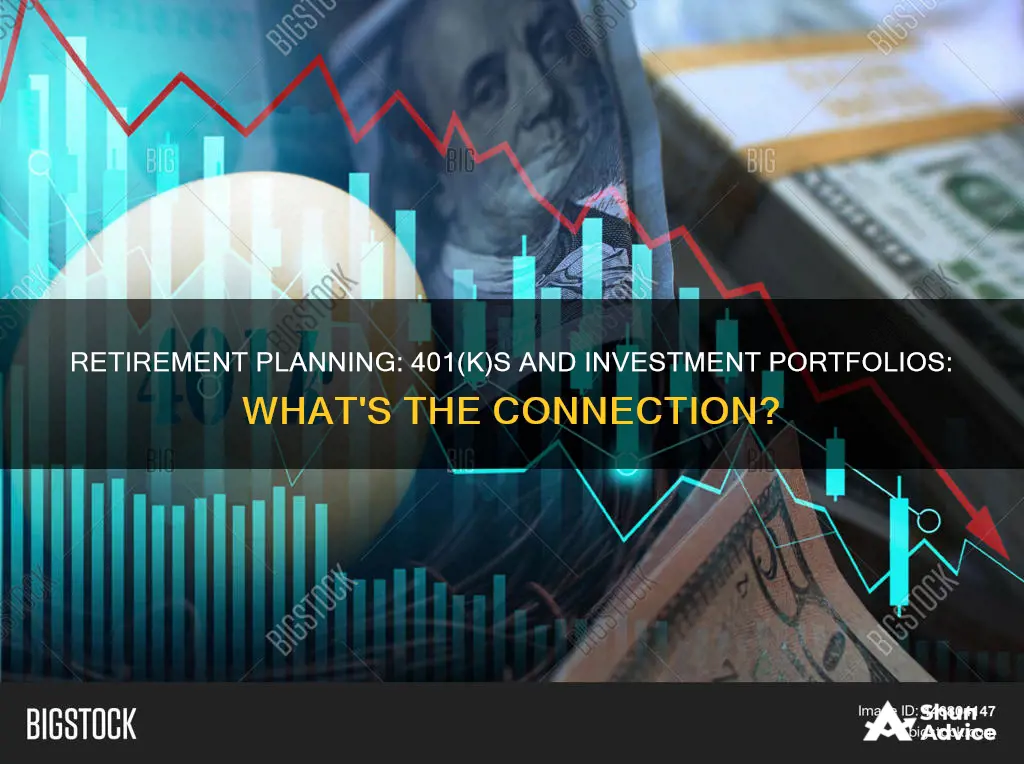
A 401(k) is a tax-advantaged retirement savings plan, offered by an employer, which allows employees to contribute a percentage of their income. There are two main types of 401(k)s: traditional and Roth. With a traditional 401(k), contributions are made pre-tax, reducing taxable income, but withdrawals are taxed. With a Roth 401(k), contributions are made post-tax, so there's no immediate tax benefit, but withdrawals are tax-free.
A 401(k) is one of the most popular ways to save for retirement, but it's important to understand how to make the most of your plan. This includes knowing how much you can contribute, how to calculate your risk tolerance, and how to pick your investments.
| Characteristics | Values |
|---|---|
| Purpose | Retirement savings |
| Type of account | Tax-advantaged |
| Contributions | A percentage of each paycheck |
| Age | Workers under 50 can contribute up to $19,500 in 2020; $23,000 in 2024 |
| Investment options | Stock mutual funds, bond mutual funds, target-date mutual funds, stable value funds, individual stocks, bonds, ETFs |
| Risk | Volatile, but safer than holding cash |
| Returns | Average annual return of 7% |
| Management | Actively or passively managed |
| Fees | Expense ratios typically below 1% |

Risk tolerance
An investor's risk tolerance is influenced by various factors, including age, investment goals, and income. For example, younger investors with a longer time horizon might be more comfortable taking on higher-risk investments, such as stocks, with the potential for higher returns. On the other hand, investors nearing retirement age might prefer more conservative investments, such as bonds, that offer guaranteed returns and lower volatility.
Aggressive investors, or those with a high-risk tolerance, are willing to risk losing money to achieve potentially better results. They tend to be market-savvy and understand the volatility of securities, employing strategies aimed at achieving above-average returns. Their investments are typically focused on capital appreciation rather than income preservation.
At the other end of the spectrum are conservative investors, who seek little to no volatility in their portfolios. They often opt for investments with guaranteed returns and high liquidity, such as bank certificates of deposit (CDs), money markets, or U.S. Treasuries.
Moderate investors aim to balance opportunities and risks, developing portfolios that include a mix of stocks and bonds.
It is important to assess your risk tolerance honestly and consider factors such as your financial circumstances, income growth potential, and lifestyle choices when determining your investment strategy.
Additionally, it is worth noting that while stocks are generally considered riskier investments, there are ways to invest in them while minimising the risk of significant losses, such as through mutual and exchange-traded funds that are tied to bonds, precious metals, or stable, slow-growth companies.
Investment Opportunities in Pakistan: Where to Invest Your Savings
You may want to see also

Asset allocation
Understand Your Risk Tolerance:
Know how much risk you are comfortable with. Generally, younger investors can take on more risk, as they have more time to recover from potential losses. As you approach retirement, it's advisable to shift towards more conservative investments. Consider how you would react to market downturns and adjust your allocation accordingly.
Diversification:
Diversifying your portfolio across different asset classes, such as stocks, bonds, and alternatives, is essential to balance risk and reward. While stocks offer higher potential returns, they come with greater volatility. On the other hand, bonds provide stability and income but typically have lower returns. Diversification ensures you don't put all your eggs in one basket, smoothing out the ups and downs of the market.
Evaluate Time Horizon:
Consider your investment timeframe. If you're investing for the long term, you can afford to ride out short-term market fluctuations and take on more risk. As your retirement date draws closer, gradually shift towards more conservative investments to protect your accumulated wealth.
Long-Term Returns and Expense Ratios:
When evaluating investment funds, consider their long-term performance over five and ten-year periods. Additionally, pay attention to the expense ratios, which represent the annual cost of holding the fund as a percentage. Aim for funds with strong returns and low expense ratios to maximize your gains.
Monitor and Rebalance:
Don't set and forget your portfolio. Regularly monitor its performance and rebalance it as needed. Over time, certain investments may outperform others, causing your original allocation to shift. By periodically rebalancing, you can maintain your desired allocation and ensure your portfolio aligns with your risk tolerance and financial goals.
Utilize Available Resources:
Take advantage of the resources provided by your 401(k) plan provider, such as fund fact sheets, investment quizzes, and financial advisors. These resources can help you make more informed decisions about your asset allocation. Additionally, consider using online tools and calculators to estimate your retirement needs and investment strategies.
Saving and Investment Economics: Core Concepts Explained
You may want to see also

Investment options
Types of Investment Options:
- Stock Mutual Funds: These funds invest in stocks and may focus on specific themes like value stocks or dividend stocks. An S&P 500 index fund, which includes large American companies, is a popular option.
- Bond Mutual Funds: These funds exclusively invest in bonds, which can include short-term, intermediate-term, or bonds from specific issuers like the US government or corporations.
- Target-Date Mutual Funds: These funds invest in stocks and bonds, adjusting their allocation based on a specific target date, usually the investor's retirement date. They offer a more conservative strategy as the target date approaches.
- Stable Value Funds: These funds invest in low-yield but safe assets like medium-term government bonds. They are suitable for investors seeking stable returns with minimal risk.
- Index Funds: These funds aim to represent a broad market index like the S&P 500 and are passively managed to follow the market's larger movements.
- Exchange-Traded Funds (ETFs): ETFs are similar to mutual funds but can be traded on an exchange like stocks. They offer more flexibility and are becoming increasingly popular in 401(k) plans.
Factors to Consider:
When evaluating investment options for your 401(k), consider the following:
- Long-Term Returns: Look at the fund's performance over five and ten-year periods, as well as its overall history.
- Expense Ratio: This is the cost of holding the fund for a year, expressed as a percentage of the invested amount. Lower expense ratios are generally preferable, as they eat into your returns.
- Risk Tolerance: Understand your risk tolerance and choose investments that align with your comfort level. Younger investors can typically tolerate more risk, while those closer to retirement may want to shift towards more conservative options.
- Diversification: Diversifying your portfolio across different investment types helps minimize risk and potentially enhance long-term returns. Consider allocating your investments across various asset classes, such as large-cap, mid-cap, and small-cap stocks, as well as bonds.
- Time Horizon: Evaluate how long you have until you need the money. A longer time horizon generally allows for more risk-taking, while a shorter time horizon may call for more conservative investments.
- Employer Match: If your employer offers matching contributions, take advantage of this benefit. It's essentially free money that can boost your retirement savings.
- Tax Benefits: Consider the tax implications of your investment choices. Traditional 401(k) contributions may reduce your taxable income, while Roth 401(k) contributions are made with after-tax dollars but offer tax-free withdrawals in retirement.
Kids' Guide to Saving and Investing Wisely
You may want to see also

Target-date funds
TDFs take more investment risks when the investor is young and gradually become more conservative as they near retirement. This is achieved through a "glidepath", which helps determine the risk exposure over the course of the investor's path to retirement by adjusting diversification levels. As the target date approaches, the fund's asset allocation gradually shifts to more conservative investment choices, reducing the risk of losses.
For example, a 22-year-old teacher planning to retire at 66 might invest in a 2065 target-date fund. As the teacher moves closer to the target date, a portfolio manager will rebalance the fund and adjust its investments so that it becomes more conservative. This allows the investor to focus on saving for retirement without having to constantly reconsider and adjust their investment choices.
TDFs are a popular choice for 401(k) plan investors, particularly those who don't have the time or inclination to review their fund's holdings and revise their investment strategy annually. However, it's important to note that TDFs can be relatively expensive in terms of fees, and it's recommended to check the prospectus before making any decisions.
Rajiv Gandhi Equity Savings Scheme: A Smart Investment Move
You may want to see also

Expense ratios
The expense ratio is calculated by dividing a fund's operating expenses by the average value of its net assets. It's important to note that these fees are charged on an annual basis but may appear on your account more regularly, such as monthly, depending on the fund.
High expense ratios can eat into your investment returns over time. The higher the fees, the less money you'll have invested in your account, as each dollar spent on fees is a dollar not compounding and growing in your portfolio. Therefore, it's crucial to aim for lower expense ratios to maximize your retirement savings.
When choosing a 401(k) plan, look for plans with low expense ratios and avoid funds with high fees. You can also consider investing in low-fee funds like index funds, institutional funds, and target-date funds. Additionally, review your plan's literature and discuss any questions with your human resources or benefits coordinator to ensure you understand all the fees associated with your 401(k).
Who is Responsible for Choosing Funds with Reasonable Expense Ratios?
Federal law imposes a fiduciary duty on retirement plan providers to offer reasonably priced investment options, including reasonable expense ratios. The Employee Retirement Income Security Act (ERISA) ensures that fiduciaries follow strict rules, including keeping expenses reasonable, managing the plan in the participants' best interests, diversifying investments, and adhering to the plan's governing documents.
In summary, expense ratios are an essential factor to consider when investing in a 401(k). By understanding how these fees work and their potential impact on your returns, you can make informed decisions to minimize costs and maximize your retirement savings.
Chris Gardner's Life Savings Investment: A Fateful Decision
You may want to see also
Frequently asked questions
A 401k is a tax-advantaged retirement savings plan offered by an employer. Employees can contribute a percentage of their income, and employers often match these contributions. There are two main types: traditional 401ks, where contributions are pre-tax, and Roth 401ks, where contributions are made with after-tax income.
When choosing investments for your 401k, consider the fund's long-term returns and expense ratios. You should also assess your risk tolerance and time horizon to determine your asset allocation. Diversification is important, so aim for a mix of stocks, bonds, and other securities.
One potential risk is being too conservative and not allocating enough to stocks, which may have higher returns over time. Another risk is paying too much in fees, so be sure to consider the expense ratios of the funds you choose. Keep in mind that all investing carries the risk of investment losses.
Yes, it is possible to lose money in a 401k, especially if you invest in stock funds, which can fluctuate with the market. However, some funds, like stable value funds, are very safe and offer guaranteed returns, albeit with lower long-term gains.
Some top-performing 401k funds over the past decade include the Fidelity Select Semiconductors Portfolio, Vanguard Information Technology Index Fund, and Fidelity Blue Chip Growth Fund. These funds offer exposure to the technology and semiconductor industries, which have experienced significant growth.







